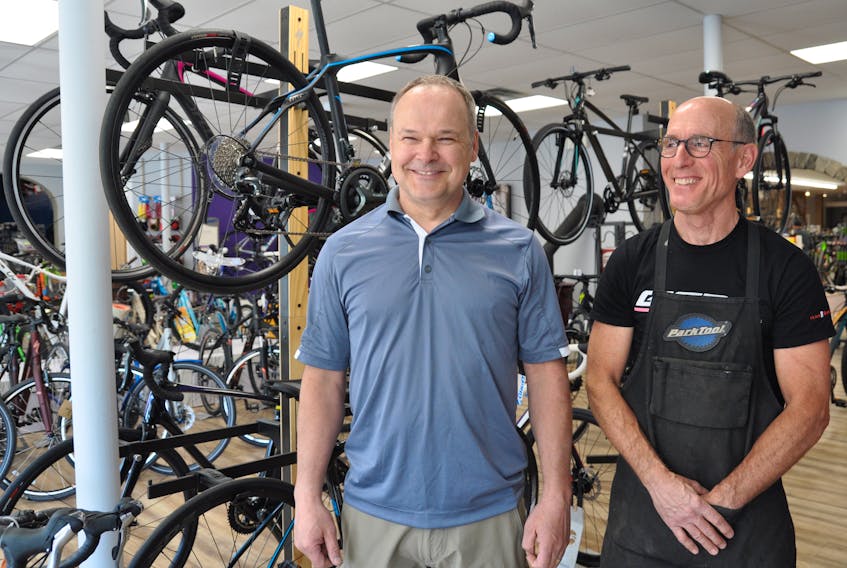KINGS COUNTY – It can be dangerous to ride a bicycle on the road in Kings County.
That is something four cyclists agreed on who’ve shared their thoughts on changes they’d like to see come through as part of the province’s new Traffic Safety Act.
The new act will replace the aged Motor Vehicles Act, which dates all the way back to 1914, and will begin its legislation process this fall. Until then, the government is accepting public input on what is needed to make roads safer for all users, and these four – Chris Banks, Bill Harvie, Doug McDougall and Ian Lemmon – have plenty of ideas of what could work.
“We have to figure out how to make it so everyone feels safe on roads. These routes are not just for cars – they’re for all traffic, of all kinds. And likewise, the rules need to be enforced for everyone, whether a car, bicycle, pedestrian, or whoever,” said Lemmon.
RELATED:
- Kentville council votes down Webster Street bike lane proposal
- Webster Street bike lane pitch sparks debate in Kentville
- Kentville's Pedal for Others cycling team preparing for a bike-a-thon that will give back to community
Make riding two-up legal a good first step
Riding two-by-two in a cycling group is illegal under the current act’s rules, yet presents the simplest method of increasing cyclists’ safety, said McDougall, who along with many groups uses the method anyway.

Banks also cited this method, known as two-up, as a safer way to cycle, though he acknowledged it may seem counterintuitive to those who don’t bike themselves.
“It’s one of the biggest things they’ve done in other countries. It’s counterintuitive, but it makes passing much safer – it forces the driver to actually go out and around them, while shortening the length of the group,” he said.
McDougall agreed, saying cars often use less distance to pass cyclists than they do a farm tractor.
“How does it make sense for a car to completely cross over that yellow line for a tractor, but sometimes give us less than a foot of space?” he said, adding he will not move over for cars who begin getting aggressive when they cannot pass.
“When it comes to cyclists, people can’t get past a cyclist fast enough. They don’t behave the same way behind a tractor – they wait until they can see.”
Enforcement of proper road etiquette also key
Bill Harvie, co-owner of Valley Stove and Cycle, says feeling scared is a weekly event, even for a regular cyclist like himself.
He and McDougall listed occasions when spit, insults and objects like bottles have been thrown at them as they bike on the road. When they’ve approached police about the incidents with information like license plates and a car description, they were told police would follow up, but no enforcement followed.

“If you’ve ever been brushed by a car or tractor – sometimes even had things thrown at you – it’s not a very good feeling,” said McDougall.
Even when cars don’t follow the minimum one-metre gap they’re supposed to allow cyclists as they pass, no tickets or fines seem to get handed out, noted McDougall.
“I can’t recall a time, ever, that someone got a fine or charge out of something like this,” said Harvie.
And proper enforcement means enforcing rules that apply to all road users – including cyclists, said Lemmon, who wants them held accountable too.
“If a cyclist makes a violation, then they too deserve a consequence. It’s got to be equal and fair,” he said.
Lack of awareness is largest barrier to safety
All four cyclists listed awareness as the biggest issue facing cyclists in Nova Scotia and the biggest challenge to safe cycling and want to see the new act take measures to better educate the general public on the rules of sharing the road.
Each recounted incidents where drivers yelled – sometimes even getting out of their car to do so – to get off the road.
“We are traffic, same as you, and there’s always this divide between both groups. The bottom line is that access to roads is a privilege that we both share a right to, along with other types of traffic,” said Lemmon.
Banks said that while a rural context could be to blame for a lack of awareness that cyclists too are allowed on roads, the problem persists in more urban areas as well, and therefore comes down to education.
McDougall agreed, saying in countries like Spain, where cyclists are more prevalent, cars knowing to yield as they pass is a direct result of increasing awareness.
“Many here don’t ride bikes, and that’s fine, but they do need to respect the fact there are people out there that this is their main mode of transportation, and they need to be able to get from work to home safely,” said Harvie.
The current Motor Vehicles Act can be reviewed here.









